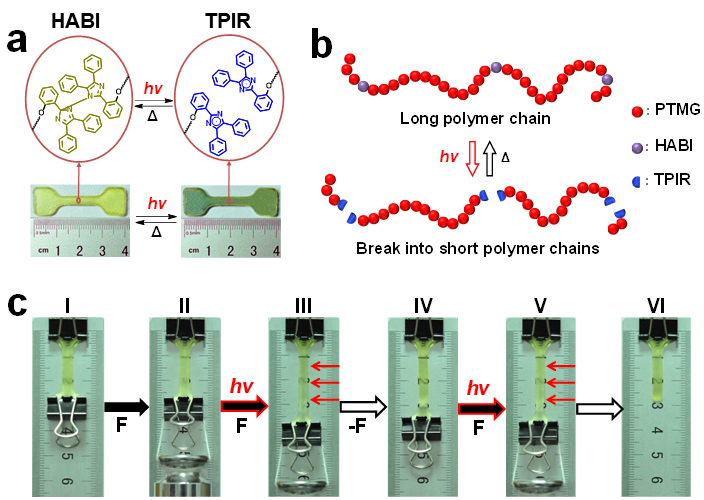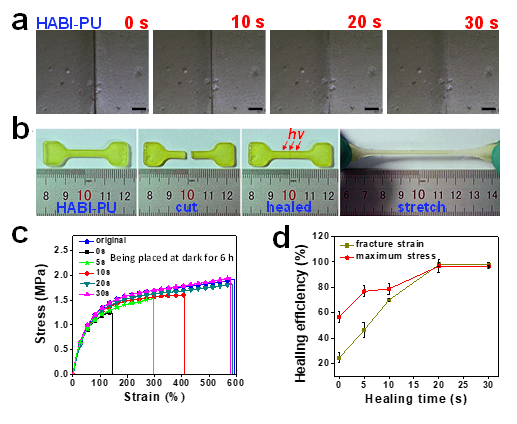Smart flexible materials based on light-responsive dynamic covalent bonds can respond to external stimuli, and convert photochemical reactions at the molecular level into macroscopic thermal or mechanical response, thereby realizing a series of biomimetic functions such as self-healing and deformation. Compared with UV light, visible light has the advantages of lower light damage, better penetrability, and relatively lower cost. To date, the development of high-performance multifunction visible light-driven dynamic covalent systems are in the ascendant. As a excellent photochromicmaterial, hexaarylbiimidazole (HABI) hasthelight-responsive dynamic covalentbond,but has received little attention.PhotoswitchableHABI units with reversible visible light response character can be integrated into polymer networks and used for the manufacture of smart polymer materials. Recently, gel materials with photoactivated shape changing capacity[ACS Appl. Mater. Interfaces, 2019,11, 23623] and double crosslinked photoplastic elastomers with photo-induced deformation ability [Chem. Mater.,2019,31, 5081] are constructed by our group. Elastomer materials with photo-induced fracture and rapid self-healing are also expected to be realized. HABI-based smart polymer materials are promising for application in the fields of photo-controlled triggers, biomimetic systems, optical machining, and photo-induced healing.
Recently, Li's group from Wuhan National Laboratory for Optoelectronic Huazhong University of Science and Technology reported a novel kind of photo-controlled reversible depolymerization elastomer (HABI-PU) materials with visible-light-induced scission and rapid healing capacities by introducing visible-light-responsive HABI molecular switch unit (Figure 1a) into the linear polyurethane (PU) system. HABI-PU exhibits excellent reversible properties and can be used asrecyclable smartmaterials.
Under 405 nm irradiation, the HABI-PU elastomers were endowed the ability of photoplastic deformation (photoplasticity) due to the reversible dissociation of the dynamic C-N covalent bonds in the HABI units (Figure 1b). Acting like a self-amputation behavior of a gecko tail, the photo-induced fracture of the HABI-PU materials occurs (Figure 1c) by prolonging the irradiation time or focusing irradiation at a fixed position when loading weight on HABI-PU elastomers at the same time.

Fig. 1The structure of photoswitchable HABI unit, photoplasticity mechanism and photo-induced fracture phenomenon of linear HABI-PU polymer elastomers.(a)Schematic representation of the reversible photocleavage and recombination of the C-N covalent bond in HABI, and the photochromism of dumbbell-shaped HABI-PU polymer material upon 405 nm laser irradiation.(b)Schematic diagram of reversible scission of polymer molecular chains in HABI-PU elastomers.(c)Photo-induced plastic elongation with loading weight upon 405 nm light irradiation. The photo-induced fracture of the HABI-PU materials occurs if the exposure time is prolonged.

Fig. 2 Rapid photo-induced healing of HABI-PU linear polymer elastomers. Photo-healing process of(a)surface scratches in HABI-PU elastomers and(b)severed damage in HABI-PU elastomers under 405 nm laser irradiation at room temperature;(c)The stress-strain curve of the cut and re-contacted sample after exposure to 405 nm for different time and placed in the dark atroom temperature for 6 h.(d)Dependence of fracture strain and maximum stress on healing time under 405 nm light irradiation in figure 2c.
Photoswitchable HABI units were introduced into the main chains of linear polyurethane backbones as the dynamic linkages. The reversible dissociation of the C-N bond of the HABI units caused the scission of long polymer chains into short chains with lower molecular weight upon irradiation (confirmed by GPC test). The temporary reduction of the molecular chain length in the irradiation area could effectively improve the peristalsis of the polymer molecular chains, thereby promoting the rapid fusion and healing of a damage area. When exposed to 405 nm irradiation, the scratches on the HABI-PU film took only 30 s to heal (Figure 2a). The more serious cut damages in HABI-PU block material could be healed after exposure for 30 s and being placed in the dark at room temperature for 6 h, when its mechanical properties can almost be restored (Figure 2b-d).
The main innovation of this work is the introduction of hexaarylbiimidazole (HABI) molecular switch units into linear polyurethane backbones to construct a visible-light- responsive elastomer materials which take into account both the mechanical properties and the excellent photoplasticity, realizing the rapid photo-healing of elastomer materials and unique photo-induced fracture function. HABI-PU is a kind of intelligent materials with broad application prospects. In addition, the photo-induced scission phenomenon of polymer molecular chains was verified by GPC test, which provides important experimental evidence for the research of HABI-based polymer materials.
The study was published onMaterials Chemistry Frontiersand supported by the National Natural Science Foundation of China, the National Basic Research Program (973) of China as well as the other funds. Shi-Li Xiang (first author), Yu-Xuan Su, Peng-Ju Zhao, Chong Li (corresponding author), and Ming-Qiang Zhu are the authors.
Title: Visible Light-Induced Scission and Rapid Healing of Polyurethane Elastomers Based on Photoswitchable Hexaarylbiimidazole Units
Full text link:https://doi.org/10.1039/D0QM00857E